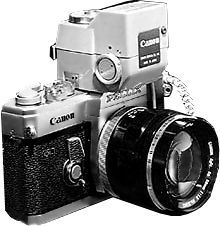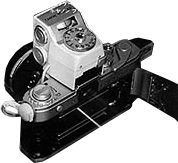Most cameras during that period
were built to last. As a top notch flagship model, Canon F-1 was built as a extremely
reliable camera to use. I must mention its robust body structure (Polycarbonate or
whatever they called, just won't survive and create any acceptance during the '60
&'70...). To ensure the F-1 can take on the harsh punishment of the hard working
professionals, their in-house testing were conducted for environment test under severe
temperatures of +60 degrees C to -30 degrees C. Other test conducted are vibration,
shock and most significant was, a new shutter mechanism and curtain were proposed
to ensure trouble free exposure cycles of 100,000 exposures. (This standard has been
maintained for the F-1n and the current EOS1n, while most Nikon's flagships' factory
datasheets have been consistantly providing figure of another minimum 50,000 cycles
extra).


The F-1
forced Canon to re-design a whole new mechanism with smoother operation and top quality
materials like this ball bearing and gear were used to ensure durability.
A new shutter mechanism was designed
along with a horizontal travelled focal plane shutter with a super-thin titanium
metallic compound screen (1/14,000th of a mm) which has a characteristic of better
stability on environment changes and more importantly, it could withstand the 100,000
exposure cycles and take on the constant endurance of higher mechanical shutter speed
of 1/2000 sec. Flash syncronisation was preset at a not so impressive figure of 1/60
sec with electronic flash.
Attention has been taken to Shutter
Speed dial and even the shutter release where it is almost noiseless and require
light touching to activate. The Dial is a non-revolving, single shaft type with equi-interval
index. Its range of film speed is such it can use any brand of film commercially
available that time. Two pins are provided for attachment. and variables speeds from
B, 1, 1/2, 1/4, 1/8. 1/15.... to 1/2000 sec. multiple series, X contact at a relative
slow speed of 1/60 sec.
Generally, during those days, permitted
technologies made engineers believed horizontal travelled shutter curtain are more
durable and stable than vertical travelled shutter curtain and can withstand a longer
life span - only with the disadvantage of longer time in closer the second curtain
of which afffecting maximum permissible sync speed. This carries over to the next
generation to the F-1n and as well as Nikon's F3, Pentax LX and even the Olympus
original OM2n (This is the only pro-caliber models from the top five that still uses
special treated "cloth-like" shutter curtain (One of my friend yelled and
complaint the use of "Cloth-like" description on his OM system today, ha!).
Anyway, no one doubts Canon's F-1's
reliability issue on the field. It was essentially needed to address these as it
was launched as a new breed of "high end" system camera. Of coz' the optional
system accessories like:
Motor Drive System
Motor Drive System has made continuous and high speed photography a reality. It is
attached in place of the bottom cover of any F-1. Two motor drives were available
for the Canon F-1.First, the odd and bulky Motor Drive Unit
and the much improved Motor
drive MF. Moreover, when
used together with the Film
Chamber 250 it can do a
variety of recording tasks. With the Servo
EE Finder, metering is
performed with EE, and shutter release and film winding by the motor. It extends
its resourcefulness to the realm of unmanned photography. The idea of expanding the
range of possible applications of the F-1 camera made the system backed up by a huge
range of accessories.
The Viewfinder
System
 |

|
The Pellix, 1965 the camera that used
a revolutionary pellicle mirror. But the later FTQL can even hook and mount with a booster
to meter lower light situation (-
3.5EV),
development of these accessories laid a good foundation for the development team
to develop an equivalent performance finder (Booster Finder) system for the Canon
F-1. - Pix courtesy of Canon Marketing -
* Quick reference
: compare with Canon F-1 Booster
Finder |
The viewfinder is the salient feature
of Single Lens Reflex cameras. The F-1 viewfinder system is quite flexible and versatile
depends on your photographic needs. Viewfinders can be chosen freely for any purpose,
such as close-up photography, macrophotography, copying, photography of moving subjects,
telephotography, long-time recording, or dim-light photography. There are four viewfinders,
two attachments, four focusing screens and seven dioptric adjustment lenses available
for the above.
The most significant features of
the viewfinders are that they have been developed with the metering mechanism as
a central idea, and the fact that they give abundant information. They are quite
easily to assembled and completely interchangeable.
Abundant Photographic
Information
Much effort has been made to include as much as possible all information necessary
in photography, for the convenience of users. This information is gathered in the
viewfinder for you to be able to judge at a glance. A unique feature of the F-1 is
the fact that this principle still holds even when viewfinders and focusing screens
are interchanged.
Automatic Flash Mechanism
The electronic flash meter-coupled mechanism is built in the F-1. It is the Canon
Auto
Tuning System (CAT System).
It has been developed within the concept of automatic flash with EE such as was introduced
in the Canonet in 1969. It is a mechanism to decide exposure by matching needles
and uses a special flash unit. In flash photography, in order to decide exposure,
it is generally required to make a calculation to determine the proper aperture,
and this must be recalculated every time shooting distance changes. However, with
the F-1, as shooting distance and the charged voltage of the electronic flash enter
into the meter circuit as signals, a proper f/stop can be decided by turning the
Preset Aperture Ring to align the aperture needle with the meter needle. Therefore,
flash photography is now as easy as exposure metering. The contact for this system
is located at the base of the accessory shoe. The electronic flash unit to be used
is the Canon Speedlite 133D which was exclusively developed for it. There are four
lenses which are applicable, and they are the FD 50mm F 1.4, F 1.8, the FD 35mm f2
and f3.5.
Well, getting a bit tired to explain
these - This site took me more than a record 10 days to construct ! Any way, I have
compiled enough info for your possible consumption - just in case you have "engaged"
yourself with a used unit somewhere, don't worry, information within this site should
able to help you understand what the Canon F-1 system can supplement you in your
photography. But I can't guaranteed prices will be low, coz' sometimes, older things
retailers might classified them as "collectible" item and might demand
much higher rates. That is why instead of worrying will the camera last, you should
spend more time
scratching your head scatching your head of how to tell the shop assistant he can't
sell those stocks other than to you...at lower price...
Concept | Reliability Issue | Motor Drive Units | Macro
| EE
Servo /
Booster Finder | Bulk Film Back | CAT
(Flash System | F1 High
Speed |
ODF-1 | Placid
| Accessories | Canon FD & FDn lenses
| Back | to Main
Index Page of Canon
F-1(n)
| Message Board |
for your Canon F-1(n)
SLR camera(s)
| Message Board | for your Canon optics
in a shared environment
| Message Board | Specifically for Dispose or Looking for Canon Photographic
equipment
Other Canon
Resources: If
you
have a New Canon F-1...
| Canon A and T Series SLR models
Lenses: FL | Canon
FDn lenses. | Early versions of FD lenses
An external source Prepared by
Christian Rollinger for Canon F1's Camera Operational
Manual
in PDF (2.58MB)
About this photographic site.


Home - Photography
in Malaysia

MB
Maintenance Team
and Credit
information:
Kaipin & Terry Carraway. Mr. Richard Yeow, General Manager
-Optical Division of Canon
Marketing
and Tony Kano, former regioner head of Canon, Asean Region for granting special
permission to reproduce some of the old manuals into HTML format. *
Canon, T90, FD Lenses,
Canon
Marketing
are registered trade names or trademarks of Canon Inc. Japan.




